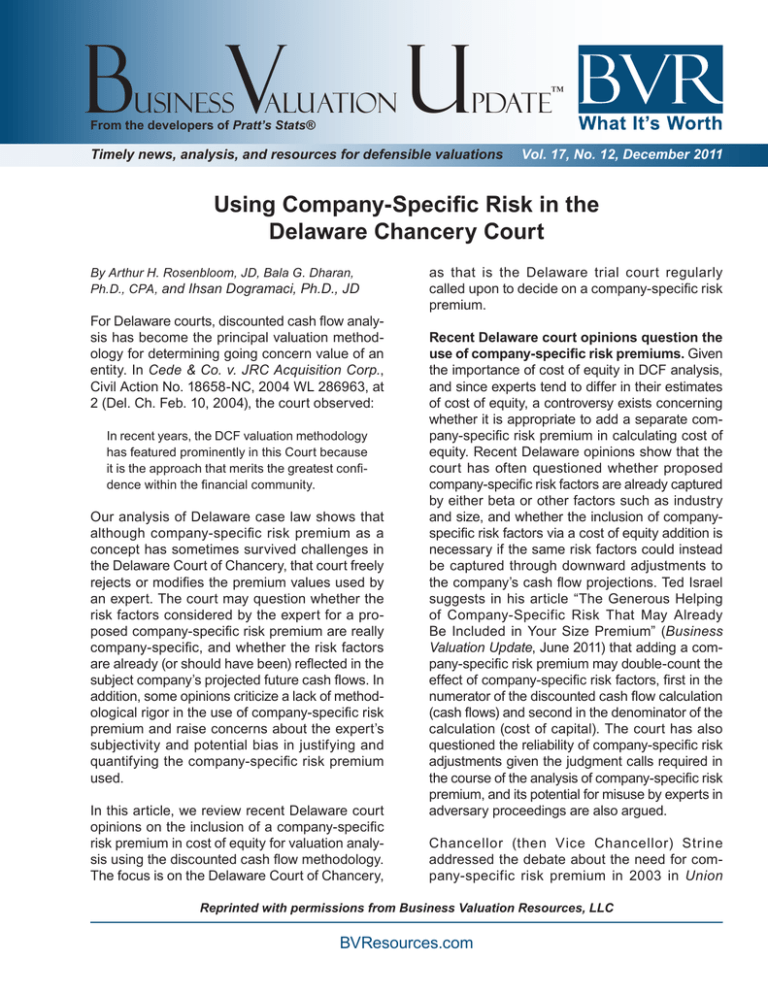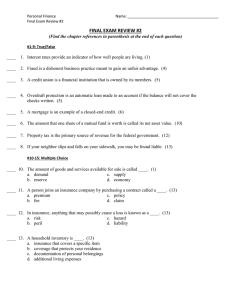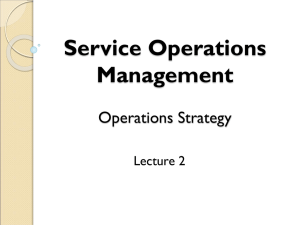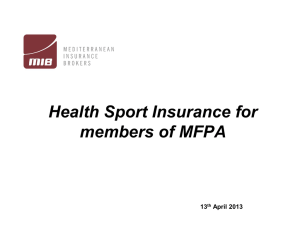
B V
usiness
aluation
From the developers of Pratt’s Stats®
U
™
pdate
Timely news, analysis, and resources for defensible valuations
Vol. 17, No. 12, December 2011
Using Company-Specific Risk in the
Delaware Chancery Court
By Arthur H. Rosenbloom, JD, Bala G. Dharan,
Ph.D., CPA, and Ihsan Dogramaci, Ph.D., JD
For Delaware courts, discounted cash flow analysis has become the principal valuation methodology for determining going concern value of an
entity. In Cede & Co. v. JRC Acquisition Corp.,
Civil Action No. 18658-NC, 2004 WL 286963, at
2 (Del. Ch. Feb. 10, 2004), the court observed:
In recent years, the DCF valuation methodology
has featured prominently in this Court because
it is the approach that merits the greatest confidence within the financial community.
Our analysis of Delaware case law shows that
although company-specific risk premium as a
concept has sometimes survived challenges in
the Delaware Court of Chancery, that court freely
rejects or modifies the premium values used by
an expert. The court may question whether the
risk factors considered by the expert for a proposed company-specific risk premium are really
company-specific, and whether the risk factors
are already (or should have been) reflected in the
subject company’s projected future cash flows. In
addition, some opinions criticize a lack of methodological rigor in the use of company-specific risk
premium and raise concerns about the expert’s
subjectivity and potential bias in justifying and
quantifying the company-specific risk premium
used.
In this article, we review recent Delaware court
opinions on the inclusion of a company-specific
risk premium in cost of equity for valuation analysis using the discounted cash flow methodology.
The focus is on the Delaware Court of Chancery,
as that is the Delaware trial court regularly
called upon to decide on a company-specific risk
premium.
Recent Delaware court opinions question the
use of company-specific risk premiums. Given
the importance of cost of equity in DCF analysis,
and since experts tend to differ in their estimates
of cost of equity, a controversy exists concerning
whether it is appropriate to add a separate company-specific risk premium in calculating cost of
equity. Recent Delaware opinions show that the
court has often questioned whether proposed
company-specific risk factors are already captured
by either beta or other factors such as industry
and size, and whether the inclusion of companyspecific risk factors via a cost of equity addition is
necessary if the same risk factors could instead
be captured through downward adjustments to
the company’s cash flow projections. Ted Israel
suggests in his article “The Generous Helping
of Company-Specific Risk That May Already
Be Included in Your Size Premium” (Business
Valuation Update, June 2011) that adding a company-specific risk premium may double-count the
effect of company-specific risk factors, first in the
numerator of the discounted cash flow calculation
(cash flows) and second in the denominator of the
calculation (cost of capital). The court has also
questioned the reliability of company-specific risk
adjustments given the judgment calls required in
the course of the analysis of company-specific risk
premium, and its potential for misuse by experts in
adversary proceedings are also argued.
Chancellor (then Vice Chancellor) Strine
addressed the debate about the need for company-specific risk premium in 2003 in Union
Reprinted with permissions from Business Valuation Resources, LLC
BVResources.com
Using Company-specific Risk In The Delaware Chancery Court
Business Valuation Update
Executive Editor:
Legal Editor:
CEO, Publisher:
Managing Editor:
Graphic & Technical Designer:
Customer Service:
VP of Sales: President:
Jan Davis
Sherrye Henry Jr.
David Foster
Janice Prescott
Monique Nijhout
Stephanie Crader
Lexie Gross
Lucretia Lyons
Editorial Advisory Board
CHRISTINE BAKER
CPA/ABV/CFF
PARENTEBEARD
NEW YORK, NY
NEIL J. BEATON
CPA/ABV, CFA, ASA
GRANT THORNTON
SEATTLE, WA
JOHN A. BOGDANSKI, ESQ.
LEWIS & CLARK
LAW SCHOOL
PORTLAND, OR
NANCY J. FANNON
ASA, CPA/ABV, MCBA
FANNON VALUATION GROUP
PORTLAND, ME
JAY E. FISHMAN
FASA, CBA
FINANCIAL RESEARCH
ASSOCIATES
BALA CYNWYD, PA
LYNNE Z. GOLD-BIKIN, ESQ.
WOLF, BLOCK, SCHORR
& SOLIS-COHEN
NORRISTOWN, PA
LANCE S. HALL, ASA
FMV OPINIONS
IRVINE, CA
JAMES R. HITCHNER
CPA/ABV, ASA
THE FINANCIAL
VALUATION GROUP
ATLANTA, GA
THEODORE D. ISRAEL
CPA/ABV/CFF, CVA
ECKHOFF ACCOUNTANCY CORP.
SAN RAFAEL, CA
JARED KAPLAN, ESQ.
MCDERMOTT, WILL & EMERY
CHICAGO, IL
GILBERT E. MATTHEWS CFA
SUTTER SECURITIES
INCORPORATED
SAN FRANCISCO, CA
Z. CHRISTOPHER MERCER
ASA, CFA
MERCER CAPITAL
MEMPHIS, TN
JOHN W. PORTER, ESQ.
BAKER & BOTTS
HOUSTON, TX
RONALD L. SEIGNEUR
MBA CPA/ABV CVA
SEIGNEUR GUSTAFSON
LAKEWOOD, CO
BRUCE SILVERSTEIN, ESQ.
YOUNG, CONAWAY, STARGATT
& TAYLOR
WILMINGTON, DE
JEFFREY S. TARBELL
ASA, CFA
HOULIHAN LOKEY
SAN FRANCISCO, CA
GARY R. TRUGMAN
ASA, CPA/ABV, MCBA, MVS
TRUGMAN VALUATION
ASSOCIATES
PLANTATION, FL
KEVIN R. YEANOPLOS
CPA/ABV/CFF, ASA
BRUEGGEMAN & JOHNSON
YEANOPLOS, P.C.
TUCSON, AZ
Business Valuation Update™ (ISSN 1088-4882) is published monthly by
Business Valuation Resources, LLC, 1000 SW Broadway, Suite 1200, Portland,
OR, 97205-3035. Periodicals Postage Paid at Portland, OR, and at additional
mailing offices. Postmaster: Send address changes to Business Valuation
Update™, Business Valuation Resources, LLC, 1000 SW Broadway, Suite 1200,
Portland, OR, 97205-3035.
The annual subscription price for the Business Valuation Update™ is $359. Low
cost site licenses are available for those wishing to distribute the BVU to their colleagues at the same address. Contact our sales department for details. Please feel
free to contact us via email at customerservice@BVResources.com, via phone at
503-291-7963, via fax at 503-291-7955 or visit our web site at BVResources.com.
Editorial and subscription requests may be made via email, mail, fax or phone.
Please note that by submitting material to BVU, you are granting permission for
the newsletter to republish your material in electronic form.
Although the information in this newsletter has been obtained from sources that
BVR believes to be reliable, we do not guarantee its accuracy, and such information may be condensed or incomplete. This newsletter is intended for information
purposes only, and it is not intended as financial, investment, legal, or consulting
advice.
Copyright 2011, Business Valuation Resources, LLC (BVR). All rights reserved. No
part of this newsletter may be reproduced without express written consent from BVR.
2
Illinois 1995 Investment Limited Partnership v.
Union Financial Group, Ltd., 847 A.2d 340 (Del.
Ch. 2003), an appraisal proceeding in which the
court based its valuation of the subject company
on the price obtained in the very merger at issue.
In dictum, Chancellor Strine remarked on the
company expert’s use of a company-specific
risk premium in calculating the company’s cost
of equity, and took note of “the debate about
whether company-specific risk premiums can be
added to arrive at an accurate cost of capital for
use in a discounted cash flow analysis.” Having
stated that the case gave him no occasion to
accept or reject the use of a company-specific
risk premium, Chancellor Strine nonetheless
continued:
I understand that investors do consider company-specific risks in calculating the cost of
capital they will use in investing money and
that investment banks use company-specific
risk premiums in advising clients. They particularly do so when a company’s shares do not
actively trade on a daily basis in a public market.
Pure proponents of the [capital asset pricing
model] argue [however,] that only systemic risk
as measured by beta is relevant to the cost of
capital and that company-specific risks should
be addressed by appropriate revisions in cashflow estimates.
The debate about adding a company-specific
risk premium to the cost of equity based on beta
is observable in other Delaware court opinions
dating back to the 1990s. In Onti, Inc. v. Integra
Bank, 751 A.2d 904, 920 (Del. Ch. 1999), the
court accepted the application of a companyspecific risk premium, but observed that in two
prior cases the court had adjusted for companyspecific risks, not by attempting to calculate a
company-specific risk premium, but rather by
adjusting the beta, on the theory that “the beta
perhaps [acted] as a surrogate company specific
risk premium.”
In Union Illinois v. Korte, No. Civ. A. 17392, 2001
WL 1526303, at 9 (Del. Ch. Nov. 28, 2001), a
Special Master’s Report (subsequently endorsed
Reprinted with permissions from
Business Valuation Resources, LLC
BusinessValuation Update
December 2011
Using Company-specific Risk In The Delaware Chancery Court
by the court) rejected a proposed companyspecific risk premium and noted that even the
expert who proposed its use “conceded . . . that
firm-specific risk would normally be included
as part of a standard projection of earnings”
rather than as a separate premium added to the
cost of equity. In Gotham Partners v. Hallwood
Realty Partners, L.P., 855 A.2d 1059, 1077 (Del.
Ch. 2003), a breach-of-fiduciary-duty action,
the court adopted nearly all of the defendants’
expert’s valuation of the business, with the exception of the expert’s use of company-specific risk
premium. The court’s reason for rejecting the
proposed company-specific risk premium was
that risks that were specific to the business had
already been accounted for in the estimation of its
beta.
In Solar Cells, Inc. v. True North Partners, LLC,
No. Civ. A. 19477, 2002 WL 749163, at 6 n.11
(Del. Ch. Apr. 25, 2002), Chancellor Chandler
articulated the following concern over the susceptibility of company-specific risk estimations to
misuse in the adversarial context—an articulation
that has subsequently appeared in a number of
Chancery decisions:
This Court has been, understandably in my
view, suspicious of expert valuations offered
at trial that incorporate subjective measures
of company specific risk premia, as subjective
measures may easily be employed as a means
to smuggle improper risk assumptions into the
discount rate so as to affect dramatically the
expert’s ultimate opinion of value.
Similarly, Chancellor Strine remarked in Delaware
Open MRI Radiology Assocs., P.A. v. Kessler,
898 A.2d 290, 339 (Del. Ch. 2006), “To judges,
the company specific risk premium often seems
like the device experts employ to bring their final
results into line with their clients’ objectives, when
other valuation inputs fail to do the trick.”
The concern about a possible built-in bias in the
analysis of company-specific risk factors has
caused the Court of Chancery to exercise caution
and demand fact-based evidence to support a
company-specific risk premium. In Gessoff v.
IIC Industries Inc., 902 A.2d 1130, 1158 (Del.
Ch. 2006), the court cited Chancellor Chandler’s
comment in Solar Cells and continued: “In accordance with that sentiment, our courts have not
applied company-specific risk premia without
fact-based evidence produced at trial on which
to base that discount.” The court in Gessoff then
rejected defendants’ expert’s proposed companyspecific risk premium on the ground that it was
“unmoored to any objective financial analysis the
court can reasonably evaluate.”
Fact-based evidence was also the issue in a
2010 case, In re Sunbelt Beverage Corp., C.A.
No. 16089-CC, 2010 WL 26539 (Del. Ch. Jan. 5,
2010, revised Feb. 15, 2010), a breach of fiduciary
duty case in which the court held that defendants
had failed to establish the appropriateness of their
expert’s use of a company-specific risk premium
in valuing the company. The court concluded: “It
is important for any proposed company-specific
risk premium to be based on a specific financial
analysis, so that the Court can verify both the
propriety of including the risk premium and the
appropriate level of the premium.”
In Le Beau v. M.G. Bancorporation, Inc., No. Civ.
A. 13414, 1998 WL 44993, at 10 (Del. Ch. Jan.
29, 1998), an appraisal proceeding in which the
valuation of the subject company hinged on valuations of its subsidiaries, the company’s financial
expert applied a company-specific risk premium
to determine the discount rate for the valuation of
one of the subsidiaries, citing risks arising from
a lawsuit and from the subsidiary’s dependence
on a key supplier. Without rejecting the concept of
company-specific risk premium, the court simply
found the concept inapplicable to the facts that
the court inferred from the evidence presented.
The court reasoned: “The underlying evidence
that these ‘risks’ were material is unpersuasive.”
In Hintmann v. Fred Weber, Inc., No. 12839,
1998 WL 83052, at 5 (Del. Ch. Feb. 17, 1998),
another appraisal proceeding, the court made
clear that it did not reject the concept of company-specific risk premium and noted that it “may
be appropriate to account for risks not captured
in the equity risk premium and the small size
Reprinted with permissions from Business Valuation Resources, LLC
December 2011
BusinessValuation Update
3
Using Company-specific Risk In The Delaware Chancery Court
premium,” but also added that the companyspecific risk premium cannot be “determined by
reference to the published results of empirical
research” and (quoting a valuation text) “‘remains
largely a matter of the analyst’s judgment.’” The
court then rejected the company’s expert’s company-specific risk premium, because the expert
had failed to provide the necessary factual
support for it and noted that the expert did not
explain “how either of his proposed reasons for
adding the extra premium translated into greater
risk.”
A concern that the expert might try to use
company-specific risk premium in a biased
fashion was articulated in In re Loral Space and
Communications Inc. Consolidated Litigation,
C.A. Nos. 2808-VCS, 3022-VCS, 2008 WL
4293781, at 30 n.151 (Del. Ch. Sept. 19, 2008), in
which the court stated that “flaws in the work of”
an expert’s valuation “leave [the court] unable to
draw any confidence from [the expert’s] work,”
and added: “In that regard, the [expert’s] use of
a 5% company specific risk premium . . . is but
one notable example” of the expert’s “too easy
willingness . . . to come up with a way to justify the
fairness of [the] deal . . . rather than a willingness
to perform real valuation work.”
When choosing between company-specific risk
premium values proposed by opposing experts,
Chancery has similarly looked for company-specific evidence or examined the experts’ potential
biases or their lack of precision. Delaware Open
MRI Radiology Associates v. Kessler, 898 A.2d
290 (Del. Ch. Apr. 26, 2006) was a combined
shareholder breach-of-fiduciary-duty action and
appraisal proceeding in which the plaintiffs/petitioners’ expert had applied a company-specific risk
premium smaller than that applied by the opposing
expert. According to the court, “neither [of the two
competing experts] explained their estimates [of
the company-specific risk] with any confidenceinspiring precision.” The court adopted the lower
estimate proposed by the plaintiffs/petitioners’
expert, and stated it was doing so “in view of the
unavoidable imprecision of the exercise.”
Similarly, in Onti, Inc. v. Integra Bank, the court
held that while the facts provided a basis for
applying a company-specific discount premium,
the reasons given by the company’s expert did
Cases in which the
court questioned the
very possibility of
applying a companyspecific risk premium
Cases in which the
court accepted the
possibility of a company-specific risk
premium but rejected
its use in the case at
hand
Cases in which the
court commented on
the susceptibility of
company-specific risk
premiums to subjective
bias
Cases in which the
court employed a
company-specific risk
premium
Union Illinois v. Korte,
No. Civ. A. 17392, 2001
WL 1526303 (Del. Ch.
Nov. 28, 2001
Union Ill. 1995 Inv. P’ship
v. Union Fin. Group, Ltd.,
847 A.2d 340 (Del. Ch.
2003)
Gotham Partners
v. Hallwood Realty
Partners, L.P., 855 A.2d
1059 (Del. Ch. 2003)
Le Beau v. M.G.
Bancorporation, Inc.,
1998 WL 44993 (Del. Ch.
Jan. 29, 1998)
Hintmann v. Fred Weber,
Inc., 1998 WL 83052
(Del. Ch. Feb. 17, 1998)
Gesoff v. IIC Indus., Inc.,
902 A.2d 1130 (Del. Ch.
2006)
In re Sunbelt Beverage
Corp., C.A. No. 16089CC, 2010 WL 26539
(Del. Ch. Jan. 5, 2010)
Solar Cells, Inc. v. True
North Partners, LLC, No.
Civ. A. 19477, 2002 WL
749163 (Del. Ch. Apr. 25,
2002)
In re Loral Space
and Commc’ns Inc.
Consolidated Litig., C.A.
Nos. 2808-VCS, 3022VCS, 2008 WL 4293781
(Del. Ch. Sept. 19, 2008)
Wacht v. Continental
Hosts, Ltd., Civ. A. No.
7954, 1994 WL 52522
(Del. Ch. Sept. 16, 1994)
Onti, Inc. v. Integra Bank,
751 A.2d 904 (Del. Ch.
1999)
Delaware Open MRI
Radiology Assocs., P.A.
v. Kessler, 898 A.2d 290
(Del. Ch. 2006)
Reis v. Hazelett StripCasting Corp., C.A. No.
3552-VCL, 2011 WL
4346913 (Del. Ch. Jan.
21, 2011, corrected Feb.
1, 2011)
Reprinted with permissions from Business Valuation Resources, LLC
4
BusinessValuation Update
December 2011
Using Company-specific Risk In The Delaware Chancery Court
not justify a premium as high as the one he had
used. The court explained: “I do not believe all
of these items [considered by the expert] are
particularly specific to the [company], especially
the ones relating to competition, dependence
on a single location, and risk of obsolescence.
Such ‘company specific’ risks apply to nearly all
companies in the entire United States economy.”
Accordingly, in its own judgment call, the court
chose to halve the company-specific risk premium
applied by the company’s expert. Likewise, in
Wacht v. Continental Hosts, Ltd., Civ. A. No. 7954,
1994 WL 525222, at 6 (Del. Ch. Sept. 16, 1994),
the court rejected in toto plaintiff’s expert’s valuation of defendant company and accepted defendant’s expert’s valuation, including a “premium .
. . based, in part, on [specific risks such as] the
uncertainty of passage of new tax laws [and]
litigation pending with the City of New York,” but
applied a 3% specific risk premium rather than
the 5% applied by defendant’s expert. And similarly, in Reis v. Hazelett Strip-Casting Corp. C.A.
No. 3552-VCL, 2011 WL 4346913, at 23 (Del. Ch.
Jan. 21, 2011, corrected Feb. 1, 2011), the court,
adopting a capitalized earnings approach to a
valuation, used a company-specific risk premium
to calculate the cost of equity of the company, but
used plaintiff’s proposed 2% factor rather than
defendants’ proposed 6% factor “because of the
dangers inherent in overestimating the companyspecific risk premium, and because [the court]
believe[d] the earnings figures [for the valuation]
underestimate the real economic returns that [the
company] generates for its owners.”
The Delaware decisions relevant to the use of a
company-specific risk premium can be summarized in the following table:
Supporting the use of company-specific risk
premium in expert reports. The judicial opinions we have reviewed demonstrate that while
Chancery has not rejected the application of
company-specific risk premium outright, it has
sometimes rejected the premium in favor of an
adjustment to the subject company’s beta or other
variables such as cash flows. In other recent
cases, Chancery has accepted the expert’s use
of the company-specific risk premium (sometimes
implicitly) but replaced the premium applied by
the expert with a smaller premium calculated
by the court. Overall, the opinions we have
reviewed show that the Chancery has been
willing to accept the use of company-specific
risk premium when it is supported by fact-based
evidence and empirically based methodological
arguments.
Arthur H. Rosenbloom, JD, is senior consultant
at Charles River Associates, New York. Bala G.
Dharan, Ph.D., CPA, is Robert B. and Candice J.
Haas Visiting Professor of Accounting at Harvard
Law School and vice president at Charles River
Associates, Boston. Ihsan Dogramaci, Ph.D.,
JD, is managing associate at Orrick, Herrington
& Sutcliffe LLP, New York. The views expressed
in this article are those of the authors and not
Charles River Associates or Orrick, Herrington
& Sutcliffe.
Reprinted with permissions from Business Valuation Resources, LLC
December 2011
BusinessValuation Update
5








